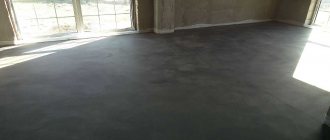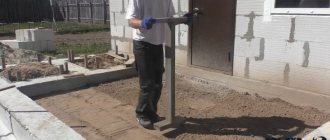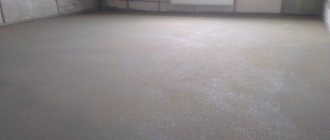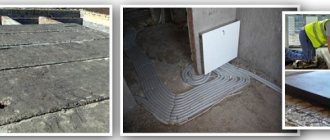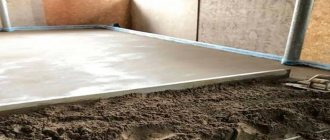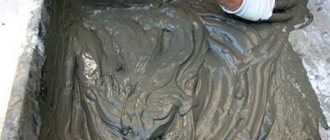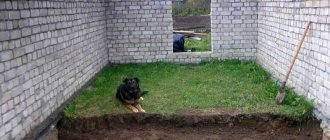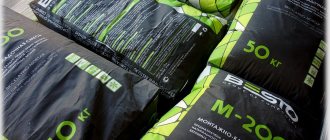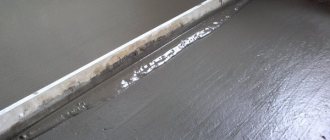Since during construction or renovation it is almost impossible to achieve a smooth surface without slopes or flaws (cracks or bumps) on which the flooring will be installed, builders use a layer of cement-sand mixture. This layer is called a floor screed.
How to prepare the surface for screed? To do this, it is necessary to perform a number of sequential works:
- prepare the surface;
- lay hydro- and sound insulation;
- mark the base for the lighthouses;
- install beacons.
Preparing the base
For a high-quality screed, you need to thoroughly prepare the base on which it will lie. When repairing the floor, it is better to remove the old screed. Over time and use, cracks, chips, and potholes appear on it. The process of destruction is accelerated by expanded clay, which in Soviet-built houses was poured under it - the backfill becomes compacted over time, forming voids under the cement screed, which is almost impossible to repair.
The increase in cost of work when replacing the floor will result in savings later, when during the service life of the new floor covering you will not have to disassemble everything again due to deformation of the screed.
The old subfloor is removed using a hammer drill. The concrete floor is cleared of debris and dust. After this, it is advisable to vacuum it and do a wet wipe. All damage to the ceiling, chips and peeling are removed. Cracks, seams and surface damage are sealed with thick cement mortar.
It should be remembered that cement mortar will not lie on concrete without preliminary preparation of the base. He'll just fall behind after a while.
Therefore, places where concrete is damaged and seams are primed. Small cracks are opened using a scalpel or a puncher, otherwise the solution cannot be rubbed into them.
Large seams are reinforced.
Concrete primer
Repairing damage to the ceiling and seams, and then priming the entire surface is carried out using:
- cement laitance;
- water;
- special primer (Ceresit ST 17).
For reference: other types of factory primer are either more expensive, or their quality is lower, or, like Vetonit, they have a short shelf life.
The purpose of the primer is to saturate the pores of the concrete with moisture in the sealing areas. If this is not done, the solution will not connect to the concrete base.
The technology for laying screed on expanded clay is discussed in detail in the materials: “How to make a floor screed with expanded clay?” and “Dry floor screed with expanded clay.”
Dry concrete will draw water out of the cement-sand mixture and disrupt the chemical hardening process of the cement. In addition, the primer binds dust particles and creates a film that improves the mutual adhesion of concrete and cement mortar.
Laitance of cement is obtained by mixing cement with water in a ratio of 1:2. The areas to be restored are wetted 2-3 times with both cement laitance and water, but without the formation of puddles. It is advisable to speed up the saturation of the pores with moisture using a paint brush. To do this, the primer is actively rubbed into the concrete with a brush. The repair solution is applied to a damp surface (wet on wet) and rubbed thoroughly.
Priming with “milk” is much more effective than wetting it with water. The cement contained in it penetrates along with water into the pores of concrete and improves the process of connecting the cement mortar with the base being repaired.
Special primers penetrate into the ceiling in the areas being repaired and crystallize there, blocking the outflow of water from the solution. On the penetration surface they form small scales that ensure adhesion of the patch to the concrete.
Repairing floors in St. Petersburg and Moscow in pre-war houses has one feature - there are no concrete floor slabs. The interfloor ceiling is made of powerful metal T-beams. Therefore, preparing the base for the screed in such houses begins with filling expanded clay between the beams, on which a layer of cement mortar is applied.
Expanded clay base
Expanded clay is a lightweight, porous material. Ecologically pure. It is used for heat and sound insulation, as well as as a filler of spaces, to reduce the load on the load-bearing elements of the building.
Before filling the expanded clay, the base of the interfloor ceiling is covered with an overlapping polyethylene film (thickness 100 microns or more) or other waterproofing material. The seams are glued together with tape. At the walls, the film is laid above the floor level.
Beacons are being installed. Expanded clay is poured in and the surface is leveled with a long lath, preventing it from exceeding the beacons. We fix the leveled layer of expanded clay in this position using cement milk, which will prevent the expanded clay granules from moving when laying the screed.
Screeds in individual houses or cottages are carried out on the ground or on the subfloor.
Soil foundation
The soil is cleared of vegetation and leveled. Expanded clay is poured onto it, at least 5 cm thick above the foundation, to provide thermal insulation and a layer of sand of 10-15 cm. The resulting surface is moistened with water and compacted for dense shrinkage. This is the cheapest method of preparing a screed, and is not inferior in efficiency to more expensive options.
Wooden subfloor (subfloor)
The wooden floor used for the base of the screed must meet a number of criteria:
- do not have rotten boards;
- be firmly attached to the joists;
- do not contain traces of glue, grease or paint;
- do not creak;
- don't bend.
The shortcomings are easily eliminated. Preparing the floor for screeding comes down to replacing rotten and sagging boards. Removing dirty stains with detergents or using sanding (plane). Creaking boards are additionally attached to the joists. Places of possible leakage of the solution (under baseboards near walls, cracks, fallen knots) are sealed with parquet putty based on wood dust or oil paint mixed with sawdust in a ratio of 1:4.
Important: water-soluble putty is not used, as it can be destroyed by the moisture of the solution.
Skirting boards are removed. A thin strip is placed in their place. The gaps between the lath and the floor are sealed with putty. After installing the screed, the lath is removed, and the remaining gap between the wall and the floor will serve to ventilate the space under the floor, which will prevent rotting of the boards and joists. After laying the flooring, it will be covered with a plinth.
The next step in preparing the base for installation is hydro- and sound insulation. Waterproofing issues are covered in detail in the work: “Waterproofing the floor before screeding.”
Floor screed diagram.
DIY concrete floor screed: detailed process with photos
Concrete flooring is currently perhaps the most common in both residential and industrial construction. It is suitable for almost any finishing coating or can, after appropriate processing, be used independently. Its main advantages, subject to the filling technology, are high strength, resistance to destruction, and durability of use. It is not surprising that when conducting private construction or when renovating an apartment, in the vast majority of cases, homeowners opt for this particular flooring technology.
DIY concrete floor screed
Is it worth inviting specialist builders, or is screeding a concrete floor with your own hands a completely affordable process for the average homeowner? This publication is devoted to answering these questions.
Types of concrete floor screeds
Concrete floor screeds can have different designs, be made using slightly different technologies and be intended for different purposes.
- Thus, they can serve solely for leveling the floor, which is carried out before installing the finishing coating. Powerful screeds serve as a reliable foundation in rooms where increased mechanical loads are expected. They can also perform the functions of ensuring the required thermal balance, acting, for example, as powerful heat accumulators in “warm floor” systems. Screeds are often used to cover communication systems. They can also be used to create a certain slope in those rooms where it is necessary.
- Concrete screeds differ according to the number of layers:
— They can be single-layer, that is, poured simultaneously to the entire calculated height. This is usually used in industrial, utility or ancillary non-residential premises, where there are no increased requirements for the evenness of the floor.
— Multilayer screeds are poured in several stages. Typically, the first layer serves as a rough base, and the top one creates a smooth surface for further flooring work. This approach is also used in cases where the total thickness of the required screed reaches too large dimensions, and it is more expedient to do it in layers.
- Screeds also differ in the degree of adhesion to the base:
Different types of ties
- Bonded ties have direct contact with the substrate. Of course, with such a filling technology, maximum homogeneity of the materials and their high adhesion to each other must be ensured. Such coatings are characterized by good strength qualities in terms of withstanding high mechanical loads. However, the condition of the surface layer will largely depend on the moisture level of the base. Such screeds are mainly performed on dry floor slabs on the floors of buildings.
— In the case where the base does not have sufficient waterproofing, a screed is used as a separating layer. A layer of waterproofing material (roofing felt, polymer film, coating composition) becomes a barrier to moisture penetration from below, and the screed itself has no contact with the base. With this technology, the layer of poured mortar cannot be less than 30 mm and, as a rule, requires reinforcement.
This technology is often used when constructing screeds on the ground, for example, in garages, sheds, basements, and on the first floors of houses without basements. They also use it in rooms with high humidity levels.
— Where enhanced thermal insulation of the floor is required or there is a need for sound insulation, floating screeds are used. In this case, the concrete solution is poured over a layer of insulation of one type or another. The screed turns into a completely independent structure - a slab, not connected either to the base or to the walls of the room. The minimum thickness of the fill in this case is at least 50 mm, and reinforcement of the screed becomes a prerequisite.
The humidity of such a screed is absolutely independent of the condition of the base; a good insulating and noise-absorbing effect is achieved. Disadvantages - excessively large thickness, and therefore - load on the floor. Typically, such screeds are used only on the first floors of residential or ancillary buildings, especially if the filling is carried out on the ground.
- Screeds can be made with a homogeneous solution or include certain fillers:
— The addition of a cement-sand solution of polystyrene foam chips significantly increases the thermal insulation qualities of the coating.
Screed using polystyrene foam chips
Typically, such screeds require a second, strengthening and leveling layer.
— Where screeds of great thickness or with increased thermal insulation qualities are required, expanded clay is added to the concrete solution.
Expanded clay concrete screed has good insulation properties
Expanded clay concrete has sufficient strength, but for laying some coatings, you will also need to fill in the front layer from ordinary mortar. But ceramic tiles can be laid directly on such a base.
-Good performance properties are shown by screeds with micro-fibre reinforcement. This technology allows you to dramatically increase the strength of the coating to mechanical loads, stretching, and bending.
Fiber fibers create an internal reinforcing structure
Such screeds usually do not crack, are less susceptible to shrinkage during hardening, and have less dust formation. They are great for underfloor heating systems.
- Concrete floor screed can be done using classic, “wet” technology, or semi-dry. Semi-dry screeding is a relatively new thing, and not everyone is still ready to try it in practice. In addition, it requires special professionalism in preparing the mortar mixture, laying out, compacting and leveling the mortar. Most home builders prefer to use proven “wet” technology, which will be discussed later in the article.
Solutions for pouring concrete screed
It is quite natural that if you need to pour a concrete screed, you will first need to decide on the type of solution. There are some options in this matter.
According to the existing canons of SNiP, the minimum strength of a conventional concrete screed, regardless of the type of further cladding, must be at least M-150 (the coating can withstand a force of 150 kg/cm²). If a self-leveling filling composition is used, then the requirements are even higher - from M-200. The solution should be selected in accordance with these requirements.
1. The “classic” concrete mortar used for pouring a regular floor screed is considered to be a cement-sand mixture in a ratio of 1:3. This “recipe” is time-tested and fully justifies itself. However, there are several nuances, without taking into account which you can easily ruin the future screed:
- To prepare concrete, you cannot use ordinary “washed” river sand that has not undergone special treatment. The frozen surface will not be durable and will begin to crumble, crumble and crack over time. The fact is that grains of sand have outlines smoothed out from prolonged exposure to water, which do not provide proper adhesion. In this regard, quarry sand is much better than its faceted grains of irregular shape. True, when choosing, you need to look carefully so that it does not contain a large number of clay inclusions - this will also reduce the strength of the screed.
The presence of a small amount of fine gravel component will not affect the strength properties of the screed. However, if a smooth surface is required, it will be necessary to sift the sand through a sieve.
- A very important condition for the strength and durability of the screed being poured is the optimally selected amount of water. It is no secret that some novice home builders, in an effort to make the work of pouring and leveling concrete easier, use an excessive amount of water, resulting in a semi-liquid, easily spreadable solution. By doing this, they are laying a “time bomb” - at the end, the screed will not have the required qualities.
Such a screed will probably not be durable.
Firstly, an excessively liquid solution will definitely shrink strongly when hardening. In this case, one cannot expect a flat surface in accordance with the set level. And secondly, a violation of the cement-water balance will certainly reduce the strength qualities of hardened concrete. The surface is loose, unbound, with increased dust formation.
There are, of course, specially calculated standards for the amount of water in concrete mortar, but they are usually adhered to by technologists at enterprises producing reinforced concrete structures and large mortar units. In home construction, people often rely on their own experience, intuition and common sense. In addition, it is very difficult to accurately calculate the amount of water due to the fact that it largely depends on the moisture content of the filler. The sand can be wet and heavy - and this is also water, which will participate in the process of preparing the solution.
Ideally, the concrete solution should be dense, but sufficiently plastic, so that when it is poured and leveled, there are no air voids left in the thickness of the floor. You can roughly focus on the following ratio - a liter of water per five kilograms of cement-sand dry mixture.
It is important to choose the right “golden mean” so that the solution is both dense and plastic
It is very difficult to mix the screed solution by hand using a shovel. It is better to use a concrete mixer or construction mixer of sufficiently high power for this. First, mix the dry ingredients in the required ratio (maybe with a little moisture), and then add water very carefully, portionwise.
An important condition for the quality of the future concrete screed is the purity of water. It is prohibited to use process water containing fats, oils, petroleum product residues, etc. Also, dirty, oily containers should not be used to carry water to the concrete mixing site.
2. The modern range of building materials on sale can significantly simplify the process of pouring screed. For these purposes, ready-made dry construction mixtures can be used.
In such mixtures, the component composition already has an optimal ratio
Compared to using the usual cement-sand mixture, this technology has a number of advantages:
- In terms of strength and other performance indicators, screeds made from ready-mixes are in no way inferior to ordinary concrete, and can even surpass it in a number of parameters.
- To prepare the solution, you do not need powerful equipment or heavy manual labor - a mixer or even a powerful electric drill (perforator) with an appropriate attachment is enough.
- In principle, there are no problems with the dosage of components - everything is already provided by the manufacturer, and the master can only strictly follow the instructions for preparing the solution.
- Many solutions prepared from such mixtures are much lighter, which reduces the load on the floor, reduces transportation costs and makes it easier to lift materials to floors.
It is possible to select the mixture to specific floor operating conditions
- It is possible to select the desired composition for specific operating conditions. Thus, there are solutions for rough or leveling screeds, for underfloor heating systems and for rooms with high humidity. Special plasticizers or microfibers added to their composition not only increase the strength characteristics of the coating, but also reduce the time it takes for the screed to completely harden, reducing the overall duration of construction work.
- What is very important for beginners is that working with such compositions is simple and does not require particularly high skills. The main thing is to follow the recommendations for pouring technology, which are necessarily attached to any batch of material.
All this will be true only if a high-quality dry mixture is purchased. Alas, there are a lot of fakes or low-quality mixtures on the building materials market in this segment. It is best to choose formulations from reputable manufacturers, be sure to check the certificate so as not to run into counterfeit products. It is also important to check the shelf life of the material - it is limited, and an expired mixture can significantly lose its quality.
The only drawback of this approach to pouring screed is that the price may be slightly higher than when making the solution yourself. Well, you have to pay for convenience and quality.
Prices for various types of screeds and self-leveling floors
Screeds and self-leveling floors
Preparing the surface for pouring concrete screed
The surface for pouring the screed is prepared in different ways, based on specific conditions:
- If the floor will be laid on the ground, for example, in a private house without a basement or basement, then the work is carried out in the following sequence:
— The soil is selected to a depth of 500 mm.
-A sand cushion 100 mm thick is poured and carefully compacted. A gravel layer is poured on top of it in the same way.
— Rough pouring of concrete with the addition of expanded clay to a height of 150 - 200 mm is done to insulate the floor surface.
— After the base hardens, it must be waterproofed - with roofing felt or thick polyethylene film to prevent the penetration of ground moisture from below. The waterproofing material must extend onto the walls to a height slightly greater than the height of the planned screed. If necessary, another layer of insulation can be poured on top, and then a reinforced finishing screed can be poured.
- In apartments, first of all, it is necessary to remove the old screed. This is done for several reasons:
— Firstly, the old screed does not guarantee integrity, since it can peel off, crack, and these deformations will be transferred to the newly poured layer.
— Secondly, do not forget about the maximum permissible loads on floor slabs. Thus, in serial high-rise buildings of old construction, the permissible load is about 400 kg per square meter - static and 150 kg - dynamic. And one square meter of concrete screed, 50 mm thick, is close to 100 kg. Therefore, all work related to thickening the screed will have to be coordinated with design organizations. And it is far from certain that such permission will be obtained.
- And thirdly, the height of the ceilings in apartments is usually not so significant that you can afford to significantly raise the floor level.
The old screed is dismantled with a hammer drill, but very carefully to prevent destruction or damage to the floor slab. The remains of the chipped concrete are removed, and then the surface is thoroughly cleaned and dust-free.
A difficult, time-consuming, but necessary process of dismantling the old screed
Next, the base is inspected and, if necessary, repair work is carried out:
- If a bonded screed is planned, then it is necessary to thoroughly clean the existing recesses, cut cracks or crevices to a width of at least 5 mm so that the concrete solution can freely penetrate into them when pouring.
- If the screed is floating or on a separating layer, then all defects must be repaired immediately. You should not leave voids under the waterproofing layer - condensation can accumulate there, and these areas of high humidity are likely to become a “problem area”.
Defects are sealed using a repair compound, epoxy putty or ordinary concrete mortar. In case of large defects, polyurethane foam can sometimes be used.
Sealing cracks and sinkholes in old subfloors
The corners between the walls and the floor are especially carefully checked and repaired - water from the concrete solution when pouring the screed can penetrate deep into the ceiling or even leak to the neighbors below.
Primer for concrete surfaces
- Then, in any case, the surface of the ceiling should be treated with a penetrating primer. This measure will additionally remove dust from the surface of the slab and improve its adhesion to the concrete being poured. In addition, the ceiling will not actively absorb moisture from the solution. This is extremely important. A lack of water in the layer of wet concrete adjacent to the base will lead to incomplete maturation of the cement stone, and the screed will peel off or collapse under even minor loads.
Priming the floor surface before pouring the screed
The soil is poured over the surface in strips and evenly distributed with a roller. In hard-to-reach places, for example in corners, it is better to use a brush.
- An elastic damper tape is glued along the perimeter of the walls. It will become a compensator for the expansion of the concrete screed, which will prevent its deformation or cracking. In addition, under no circumstances should the screed come into contact with vertical structures, be they walls, partitions or columns.
Damper tape is glued around the entire perimeter
- If the screed is on a separating layer, then first the entire surface of the ceiling is covered with a dense polyethylene film, at least 0.2 mm thick. The strips are overlapped by at least 100 mm. The joints must be taped with waterproof construction tape. You need to try to very carefully lay the film in the corners so that strong wrinkles and folds do not form - air “pockets” may remain there. The edges of the film on the walls should be 5 ÷ 10 mm higher than the planned screed - it will be easy to trim them later.
Schematically - waterproofing film and damper tape for screed on the separating layer.
After the polyethylene is laid, the damper tape is glued - just as mentioned above.
Beacon system and reinforcement
To achieve horizontal screed and its required height, it is necessary to create a system of beacons along which the concrete mortar will be leveled.
Definition of zero level
It’s very good if you have a laser level on your farm or if you have the opportunity to borrow one from friends. In this case, the work will be significantly simplified - it will be much easier to cut horizontal stripes on the walls and control the level of alignment of the guides.
The presence of a laser level will greatly simplify the work
If this is not possible, then you can set up beacons just as well using a water level and a regular building level.
Time-tested hydraulic level
The water level consists of two cylindrical transparent vessels with the same scale applied, connected by a long elastic thin hose. According to the physical law of communicating vessels, the liquid level in them is always at the same height from the horizon. Thus, having made one mark at a certain level, it can be transferred with high accuracy to other surfaces within the length of the flexible hose.
Marking begins by determining the zero level of the future screed. To do this, first of all, you need to draw a basic horizontal line. This is done as follows:
- The estimated highest corner of the room is visually determined. A mark is made on the wall in this corner at an arbitrary height. It is better, of course, to make it so that it is as convenient as possible to work, for example, one and a half meters from the floor.
Making marks to draw a horizontal baseline
- Using a water level, this mark is transferred to all walls of the room. The distance between the risks should allow you to connect them with a line using an existing ruler (you can use a long building level or a pure rule).
- The drawn line should run along the entire perimeter of the room and close at one point - this will indicate the correctness of the measurements.
- Measurements are taken from the applied baseline to the floor surface. Measurement points are usually every 0.5 m. It is imperative to ensure that the measurement is carried out strictly vertically. The obtained values need to be written down (on a piece of paper or even on the wall with a pencil).
The measurement point that gives the minimum height of this distance will correspond to the highest section of the base.
An example of how to mark the zero level
- The thickness of the future screed is subtracted from the obtained value at the highest point (minimum 30 mm). For example, the minimum height is 1420 mm. We subtract the thickness of the screed (30 mm) and get 1390 mm. This is the distance from the plotted reference line to the zero level.
- Now it will not be difficult to draw the entire zero level line around the perimeter of the room - to do this, you need to measure the resulting value from the base down, mark the points and connect them with a straight line. To simplify your work, you can make a template and quickly move the marks from the base line. After connecting them, you get the main line of the zero level.
- In construction practice, it is rare, but it still happens, when in the center of the room the floor level is slightly higher than at the walls. This must be checked by pulling the cord at the zero level between opposite walls and measuring the height from it to the floor. A similar check should be carried out in several places. If it is determined that there is a hill in the center, it will be necessary to shift the zero level upward to ensure the minimum permissible thickness of the screed over the entire area of the room.
Marking for beacon system
It is advisable to mark the beacons and guides immediately after hitting the zero level, guided by the following principles:
- The orientation of the guides should correspond to the intended direction of the most convenient pouring of the screed. This is usually done along the room, from the far wall to the exit.
- It happens that due to the complexity of the room configuration, it will be necessary to change the direction of pouring in a certain area. This should also be immediately taken into account when marking beacon lines.
- The distance between the wall and the parallel guide closest to it is usually maintained no more than 250 - 300 mm. If you leave it large, a poorly leveled area or even a failure may form along the wall, which will require additional intervention later.
The rule should protrude approximately 200 mm from the guides on each side
- The distances between adjacent guides are not particularly regulated. The main thing is that the leveling rule installed on them protrudes on both sides by about 200 mm. The guides should not be spaced too far apart - quite large gaps may appear in the center between them after the hardening concrete shrinks.
- I distribute the guide lines across the width of the room, usually at the same distance from one another.
How to set beacons and zero level guides
Previously, various improvised materials were used as guides for the beacon system, for example, wooden blocks or unnecessary pipes. Today, metal profiles are mainly used for these purposes.
- Thus, galvanized U-shaped profiles from plasterboard systems perform very well. They are resistant to deflections and create a reliable “rail” for working as a rule.
- Plaster profiles are very popular, although they are not without some disadvantages. They have a stiffening rib, but on long sections when working as a rule, they can still sag. Therefore, when using them, the number of support points must be increased.
- In some cases, you can do without using profiles altogether.
There are many ways to install a beacon, and it is impossible to consider everything. Let's look at just a few of them.
- One of the most accurate and simplest is using self-tapping screws.
— At the far end of the room, at a distance of 250 - 300 mm from the corner between opposite walls, a strong cord (for example, a fishing line or a thick nylon thread) is pulled strictly at the zero level. It is important to tighten it as much as possible so that there is no sagging in the center.
Setting self-tapping beacons to zero level
— At the intersection of the line of the extended cord with the line closest to the wall, the guide, a hole is drilled in the floor, into which a plastic dowel is hammered and a self-tapping screw is screwed in. Using a screwdriver, it is screwed in so that the upper edge of its cap exactly coincides with the zero level.
— A similar operation is repeated on the opposite side of the room, closest to the exit.
— Two self-tapping screws defining the guide line are connected to each other with a tightly stretched cord, so that it runs along the top of their heads.
— On this section, mark and drill holes for dowels, distributing them evenly so that an interval of 350 ÷ 400 mm is maintained between them.
— Self-tapping screws are screwed into dowels until their heads coincide with the tensioned cord. A check must be carried out using a building level - if necessary, the required adjustments can be made.
— In the same way, a line of screws is made on the opposite guide, and then on the intermediate ones. In this case, the check must be carried out in all directions - longitudinal, transverse and diagonal.
— Once the same zero level has been reached along all lines, the stretched cords are removed. Prepare a thick concrete solution. It is laid out in small slides along the line of screwed-in screws. Then a U-shaped profile is put on top and pressed into the solution. The transverse flange of the profile should rest against the head of the screw. It is important that the profile “sits” evenly on both sides, without distortions.
Installation and fixation of metal profiles - guides
— After the solution has set and securely fixed the profiles in the installed position, you can proceed to pouring the screed.
With plaster profiles it turns out to be somewhat more complicated - it is more difficult to fix them using the heads of the screws. For these purposes, special fastening elements can be used - “eared” ones, which are placed on self-tapping screws, and their petals are used to crimp the side flanges of the profile.
Video: placing beacons using self-tapping screws and “eared” fasteners
Another subtlety is that plaster profiles also have their own height, and this must also be taken into account when setting the screws to the zero level.
In addition, much more fixing solution will be required - to the point that I even resort to laying out a solid shaft into which the profile is embedded with emphasis on the screw heads.
Fixing thin plaster profiles with mortar
- Some craftsmen are accustomed to doing without metal profiles altogether.
“They tie the exposed self-tapping beacons together with thin wire, thereby creating a kind of reinforcement frame. Then the solution is laid out along the entire line in a slightly excess quantity, so that the resulting shaft is slightly above the zero level.
— When the solution begins to set, a guide plane is formed. Using the rule, the upper edge of this shaft is compared and smoothed down to the screw heads.
- After hardening, you will get excellent guides along which you can work as a rule, and then they will enter the structure of the poured screed.
- If the screed is carried out over laid waterproofing, then the self-tapping method becomes inapplicable - the tightness of the film cannot be broken, and in addition, there should be no rigid adhesion of the new screed to the base. In this case, you will have to tinker more, laying out piles of mortar and accurately inserting the guides at the zero level along the stretched cords.
To speed up the readiness of the beacon system, tile adhesive is often used instead of conventional mortar - its hardening time is much shorter. But gypsum compositions are unacceptable. Firstly, they practically do not shrink, unlike cement ones. Secondly, gypsum compositions have completely different indicators of water absorption, adhesion, strength, ductility, etc. We can say with 100% certainty that cracks will appear on the screed at the locations of the beacons.
Nuances of screed reinforcement
Of course, this measure is useful, especially with thick ties. Most often, a metal mesh made of galvanized steel wire with cells from 50 to 100 mm is used for this - it can be purchased ready-made in stores. Only when placing it, many people make a serious mistake.
If you look at numerous photographs on the Internet, you can see a mesh laid directly on the floor slab or on a layer of waterproofing. There are many doubts about the usefulness of such reinforcement. Ideally, for the reinforcing belt to play its role, it should be placed in the thickness of the mortar being poured, approximately in the middle of the height of the screed.
Two mistakes at once: the reinforcement lies on the floor surface, and the beacons are installed on gypsum mortar
To do this, you can purchase special polymer stands. However, it will not be difficult to make supports from wire or even to raise the mesh on linings from pieces of broken tiles or fragments of old concrete screed. Wooden pads should not be used under any circumstances.
Convenient polymer stands for installing reinforcing mesh
Obviously, it is necessary to install the reinforcing grid before setting the guides. Most often, the installation of the beacon system and reinforcement is carried out in parallel, and the mesh can also be fixed on those piles of cement into which metal profiles are embedded.
Video: Some more tips for installing a beacon system
Filling the screed
Oddly enough, the process of pouring the screed itself looks, in the series of all technological operations, probably the most uncomplicated. If all the preparatory work is done correctly, then this stage will not be difficult.
- For normal pouring and hardening of the screed, the optimal temperature is from 15 to 25 degrees. It is also possible to carry out work at lower temperatures (but not lower than +5), but the maturation period of concrete will increase significantly. In too hot weather, it is also better to refrain from pouring - = the top layer can quickly dry out and crack. It does not like screed and drafts, although the access to fresh air cannot be completely blocked.
- It is best, of course, to work together - one is preparing the concrete solution, and the second is directly pouring and leveling the screed. The technology for mixing the solution has already been described above.
- Work is carried out from the far corner of the room, gradually moving towards the exit. You should try to complete the pouring within one working day - this way the screed will be as uniform and durable as possible. If for some reason this is not possible, then the floor surface is divided in advance into sections (they are called fill maps) with jumpers installed between them.
- The finished solution is spread in excess quantities between the guides, so that its layer is 15 - 20 mm above the zero level. Initial distribution is carried out using a trowel or shovel. It is imperative to ensure that there are no empty spaces left - this often happens under guides, under reinforcement bars or in corners. It is necessary to achieve maximum compaction of the concrete solution and release of air bubbles from it. To do this, you can carry out “bayoneting” - the solution is pierced with a shovel or trowel before leveling.
- Next, a rule is set on the guides. Using forward and transverse zigzag movements, the solution is leveled to the level of the guides, so that a flat, smooth surface is obtained.
Directions of movement as a rule
If the sand has not been sifted and large fragments (pebbles or shells) remain in it, then certain difficulties may arise - these inclusions can leave grooves and you will have to suffer a lot, removing them and smoothing out the unevenness in order to bring the surface to an ideal state.
After the rule, there should be a flat, smooth surface
Concrete mortar is added as needed so that work continues uninterrupted. Excess mortar is carefully removed at the end of filling the room.
Video: a visual example of pouring screed along beacons
After the filling is completed, it is necessary to take measures to prevent accidental entry of people or pets into the premises during the first 5 to 7 days. In order for the ripening process to proceed effectively, the surface must be moistened with water daily (starting from the second day), keeping it moist. In extreme heat, it makes sense to cover it with film after initial setting to avoid drying out.
If a regular sand-cement mortar was used, then the readiness of the screed to withstand operational loads can be said no earlier than after 3 weeks. When using dry building mixtures, the timing may be different - they must be indicated in the attached instructions.
After the screed is ready, it is checked for evenness and surface quality. To do this, set a rule on the embedded guides and measure the resulting gap in the center. There is no escape from concrete shrinkage, and if the gap does not exceed 1 - 2 mm, then this will be within normal limits.
Often a thin layer of self-leveling compound is poured over the screed to make the surface perfectly smooth. However, this is a topic for separate consideration.
Waterproofing
When carrying out construction or repair work on flooring with their own hands, many people equate waterproofing work with installing a damper tape. Yes, the tape partially plays the role of a sound and waterproofer, but only at the junction of the wall and the floor. It does not protect the subfloor from moisture from the basement or leakage in rooms with high humidity (bathrooms).
Important: waterproofing the base floor is required in individual houses without a basement. Capillary moisture and evaporation of water from the soil under the building destroy the foundation, the screed, and the floor itself. The problem is aggravated if the moisture has an aggressive (acidic or alkaline) environment. By interacting with the components of concrete, it renders it unusable within several years.
There are various methods of waterproofing:
- Gravel-sand cushion. Used in private houses on the ground floors;
- Film. Suitable for all types of apartments and houses. It is simple to use, which allows a novice builder to perform such preparatory work. In terms of cost, it’s a budget option. There is only one disadvantage: it cannot be laid on a base with many pipes;
- Coating waterproofing based on rubber or bitumen. Apply in several layers. Penetrates into all cracks, which guarantees the quality of the work performed;
- Impregnating waterproofing (Penetrat). A new type of insulating material. Its peculiarity is that it can be applied from any side of the concrete - by reacting with the components of concrete, the impregnation grows special crystals throughout the entire thickness of the concrete floor. Crystals prevent moisture penetration.
Film waterproofing.
Gluing damper tape
To insulate the screed, a damper tape is laid near the walls, which performs several functions:
Scheme of screeding an expanded clay floor on the ground.
- Waterproofs corners and joints.
- Insulates walls.
- Compensates for temperature changes.
In other words, this material prevents moisture leakage on the lower floors when pouring and prevents the formation of cracks when the screed dries.
Insulating tape is sold at any specialized markets or stores, but it is also possible to save money, since it is easy to make it yourself from building materials available at hand. As available means, you can use plastic film, waterproofing material, and roofing felt.
Industrially produced damper tape is easy to glue to walls. You need to remove the protective film and press the material with an adhesive backing to the wall panel. When gluing in the corners, you need to make an incision at the point of contact with the floor surface; the joints are overlapped.
If, after all, a tape was chosen from the available means, then the material is cut into strips, applied to the wall and laid around the perimeter. The width of the strips depends on the height of the screed, and the protrusion of the insulation on the wall should slightly exceed the thickness of the future fill. The homemade tape is attached with liquid nails, and the overlap must be about 150 mm. After drying, the edges that will be higher than the screed are trimmed with a well-sharpened knife.
You may be interested in: Laminate flooring technology
Noise insulation
Sound insulation is necessary for residents of apartment buildings, starting from the second floor. Music, children's screams, loud TV, etc. become a problem for the upstairs neighbor for many years. This can be solved by laying soundproofing material on the floor. In this case, depending on the type of flooring, soundproofing material is placed under the screed on the slab (floating screed), or on the screed itself.
Various materials are used for floating screeds:
- polystyrene;
- mineral wool;
- perlite;
- expanded clay
Its device is not very complicated, but it requires certain knowledge and skills. Not applicable for certain types of floors. In such cases, soundproofing materials are laid between the screed and the floor. Instructions for soundproofing a floor screed are given in the article: “Soundproofing the floor in an apartment under a do-it-yourself screed.”
Important: carrying out soundproofing work almost always solves another problem - floor insulation.
Floor surface primer
Priming the surface with a special impregnation
The preparation of the base for self-leveling floors is completed by applying a primer, which is designed to ensure high adhesion of the materials. Experts recommend using a special primer containing a fine fraction of quartz sand to impregnate the surface; this will make the surface rough and ensure high quality adhesion of materials. The surface of the base should not be smooth, as this will impair adhesion and affect the quality of layer leveling. It is advisable to apply the primer in several layers and allow at least 4 hours to dry after each layer. After applying the last layer of primer, it is necessary to dry the surface for 24 hours and only then the base under the self-leveling floor will be ready for further work.
Rules for laying linoleum on a wooden floor and preparing the base
Important. While the primer is drying, it is not recommended to use air conditioners or air heaters; it is also advisable to avoid possible drafts, as this will lead to uneven drying.
Marking the subfloor
The floor surface before the screed always has defects:
- slope, while in different rooms in different directions;
- bumps and protrusions in concrete that cannot be removed, etc.
To level out these shortcomings, it is necessary to find a conditional horizon above which the base of the floor will not be visible in all rooms of the room. This is achieved by drawing the zero level (horizon line), and then, with its help, the floor screed line. These lines are marked with a construction cord along the walls of the rooms or drawn with a pencil according to a strip or rule.
For information: in the work “How to check the floor level in an apartment yourself?” shows how to take measurements correctly.
The next stage of drawing is calculating the number of rows of beacons and the distance between them, marking their location on the base of the floor with chalk.
Priming: nuances
The concrete-sand surface is considered a material that quickly absorbs moisture, so it is recommended to use the same solutions for priming that are manufactured in factories.
You may be interested in: Features of a screed floor
To ensure quality, it is better to apply the primer in two steps, with the next layer applied after the first has completely dried. To thoroughly prime all small imperfections on the floor surface, use a priming brush.
When choosing a primer, first carefully read the instructions for use.
Since some compositions are recommended to be applied to a wet primer, this should absolutely not be done.
When the stage of priming the surface is completed and it is completely dry, you can begin the next finishing work.
Installation of beacons
Preparing the floor for screeding ends with the finishing work - installing beacons. The type of beacon depends on:
- financial capabilities of the customer;
- construction experience;
- type of screed;
- urgency of work;
- availability of materials.
Properly installed beacons allow you to obtain a high-quality screed, which, in turn, guarantees a durable floor.
The work on installing beacons is discussed step by step in the article: “How to install beacons for floor screed?”
Choosing a mixture for self-leveling floor
The first thing you need to do before you start arranging the finishing self-leveling floor with your own hands is to select the appropriate material. Mixtures for self-leveling floors are presented in a huge number of varieties and options, differing in characteristics, quality, and price. How do you know which composition to choose?
Criteria by which you should choose a mixture for installing a self-leveling floor:
- Compound. Self-leveling mixtures can be based on a cement or gypsum binder component, in addition to which the composition contains sand, mineral fillers, and special modifying additives. Self-leveling cement flooring is the most inexpensive and versatile option, characterized by high wear resistance, strength, and moisture resistance. Gypsum floors dry quickly and allow you to create a thicker layer, but they are susceptible to moisture, so they are only suitable for dry rooms.
- Layer thickness. Varies from 1 to 100 mm for different compositions. For cement - up to 10 mm, for gypsum and complex - more.
- Speed of setting and hardening. All poured floors dry quickly, but gypsum floors can be walked on earlier than cement ones, approximately 3-4 hours after completion of work.
- Mixture consumption. Varies between 13–18 kg per square meter. m. with a layer thickness of 10 mm. For a cement floor it will be larger than for a plaster floor.
If you are thinking about how to make a poured floor with your own hands, first of all you should be interested in the composition and approximate thickness of the pour. When choosing, you should be well aware of the unevenness, differences and slope in the room in which you will make a self-leveling floor for the finishing coating with your own hands; it is from their dimensions that you need to start.
USEFUL INFORMATION: Do-it-yourself installation of electric heated floors under tiles
Many mixtures for poured floors successfully replace screed, and are also used when pouring pipes of a “warm floor” system.
Calculation of material consumption
Before making a self-leveling floor with your own hands, you should correctly calculate the consumption of the dry mixture, leaving a small reserve. The norm is from 1.3 to 1.8 kg per 1 sq. m of area per 1 mm of layer thickness. It turns out that if you need to fill a layer of 8 mm, the calculation will be as follows:
1.8 × 8 = 14.4 kg/sq. m.
